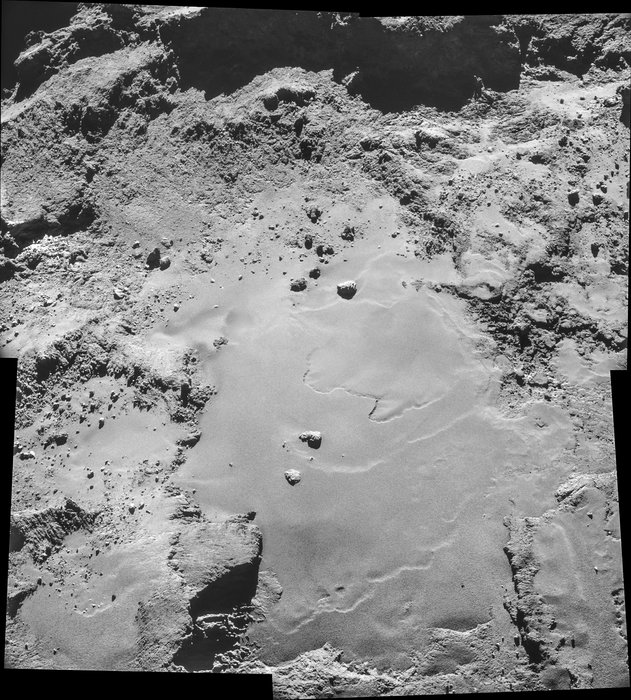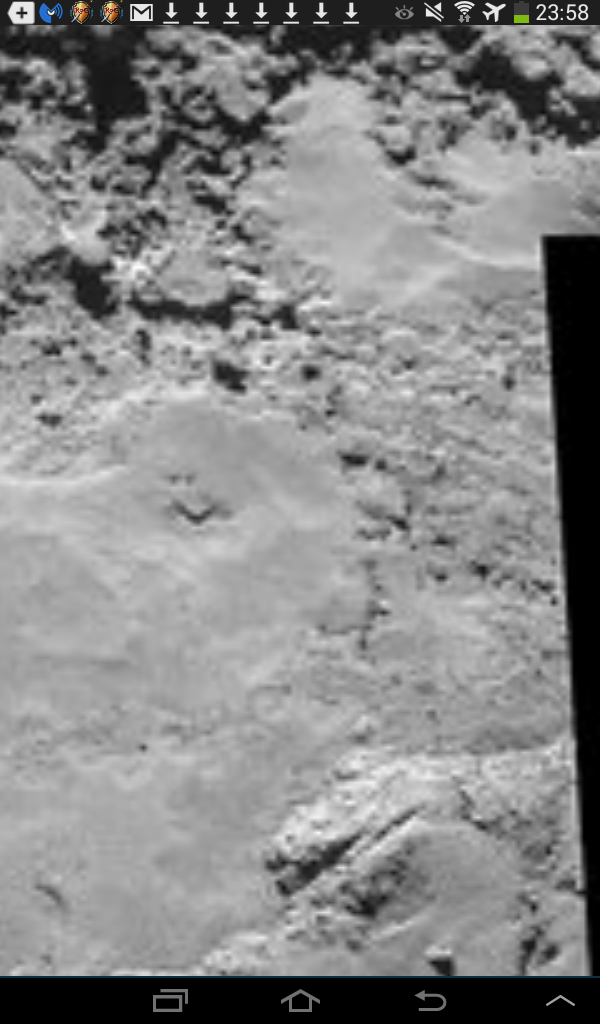Boulders ~they appear in strange places!
-
 by
p.titchin
by
p.titchin
I have just seen the stunning photo's from the Rosetta probe. It shows some remarkable boulders on the surface of 67P/Churyumov-Gerasimenko. A fascinating mystery as to how they got there. 😃 ~Pete
Posted
-
 by
Kitharode
moderator
by
Kitharode
moderator
Hi Pete: Any chance of you posting an example here? Or a link? Cheers.
Posted
-
 by
p.titchin
in response to Kitharode's comment.
by
p.titchin
in response to Kitharode's comment.
Hi Kith, Ive been following the mission on line, don't know how to get the link, but www.space.com/24266-rosetta-comet-mission-photos-esa.html has a flavour,with a click through raft of pictures. There is also an article with the pictures and a video in todays online 'daily mail' (its free). Get the homepage up, and click on 'science', it's the lead article. ~Pete
Posted
-
 by
mschwamb
scientist, translator
by
mschwamb
scientist, translator
The other half of my life is Kuiper belt objects, icy remnants left over from planet formation orbiting beyond Neptune, so I thought I'd join in the fun discussion. My PhD thesis was on studying the small bodies of the Kuiper belt and the region beyond in the inner Oort cloud.
There's a nice discussion on Rosetta I watched recently you might find interesting.
Cheers,
~Meg
Posted
-
 by
Kitharode
moderator
by
Kitharode
moderator
Pete: Thanks for that. I'll give it a go.
Meg: Our Astrogang were talking about the Oort cloud recently and you might be able to add something here. We're of the opinion the the cloud is still theoretical rather than proved (?) We also considered the possibility of other, relatively nearby, stars having their own Oort cloud giving rise to the possibility of comets coming from 'their' cloud, rather than 'ours'.
What say you? 😃
Posted
-
 by
p.titchin
in response to mschwamb's comment.
by
p.titchin
in response to mschwamb's comment.
Thanks Meg for the link. I have seen it before, but its great to be able to take time to listen to it again in 'slow time'. Nice to find another Kuiper belt fan, though I'm just an interested amateur,so it's great to have a qualified expert on the thread.. What think you about the accretion theories? I find the boulders on this comet interesting. I can see 'flow' on the surface, but am I right in thinking this is on top of 'ice'? ~ Pete
Posted
-
 by
mschwamb
scientist, translator
in response to Kitharode's comment.
by
mschwamb
scientist, translator
in response to Kitharode's comment.
Yes it exists. We have detected an object residing in the Oort cloud, but we've detected comets on their way in for the first from the Oort cloud. The distribution of orbits tells is consistent with the spherical shell around the solar system at around 20,000 AU.
Our nearest star is 1 parsec away, so our Solar System is pretty isolated that our comets are coming from our Oort Cloud but earlier on in the Solar System's history we could have had been a stellar cluster and an exchange of Oort cloud material could have happened between stars or at least dynamically it has been shown to be possible if you make some assumptions about the extent and size distribution of material.
Cheers
~Meg
Posted
-
 by
wassock
moderator
by
wassock
moderator
So what's the biggest orbit that there could be? Is there a limit? If something drops in from Ort will it come back again, would we ever know?
Posted
-
 by
p.titchin
in response to mschwamb's comment.
by
p.titchin
in response to mschwamb's comment.
I see the New Horizons craft is still on target for its Pluto flyby in July next year, and they are already finding other targets in the Kuiper belt for her to investigate, after the Pluto flyby Looks like an interesting "watch this ' space' 😉 " for next year. ~Pete
Posted
-
 by
mschwamb
scientist, translator
in response to wassock's comment.
by
mschwamb
scientist, translator
in response to wassock's comment.
Yeah. We can tell from the orbit whether it's pristine or has been around a few times. Like comet ISON was on its first encounter. Comet Hale-Bop has been around before. I think the Egyptians would have seen in it. The limit is what would stay bound from the Sun after a giant molecular cloud or a neighboring star passes by. other things would have have been stripped as the solar system has gone around the Milky Way. The objects in the the Oort cloud are at something like 10,000-20,000 AU to 10^5 AU.
Cheers,
~Meg
Posted
-
 by
mschwamb
scientist, translator
in response to p.titchin's comment.
by
mschwamb
scientist, translator
in response to p.titchin's comment.
Yeah it's pretty exciting since it's going to a cold classical Kuiper belt object. There's much observational evidence these things formed in place where they are now where as bigger objects like Pluto which are part of the dynamically 'hot' population with more excited orbits were emplaced during Neptune's migration, so we'll get to sample a different part of the Kuiper belt and possibly the conditions in the early Solar System during planet formation that the cold classical formed in.
Cheers,
~Meg
Posted
-
 by
mschwamb
scientist, translator
in response to p.titchin's comment.
by
mschwamb
scientist, translator
in response to p.titchin's comment.
I'm not sure about whether the pebble is a pebble or some conglomeration of ice and rock. It will be interesting to see what the chemical composition of the surface of the comet is. I'm looking forward to hearing about the Rosetta results over the next few years.
I study these icy bodies in the outer Solar System as populations or as point sources so the fact to get up close to a comet is really exciting.
Cheers,
~Meg
Posted
-
 by
p.titchin
by
p.titchin
Absolutely brilliant pictures from Rosetta just released by ESA of 67P/Churymuov-Gerasimenko. Hi definition .Simply stunning, just google rosetta to get all the latest. Quicker than me trying to do links! I've got hours of fun trying to get my head round the surface shown here, and I feel it has relevance to my thoughts when I look at the Mars images.~Pete
Posted
-
 by
wassock
moderator
by
wassock
moderator
http://www.esa.int/spaceinimages/Images/2014/10/Comet_on_26_October_NavCam

Posted
-
 by
mschwamb
scientist, translator
by
mschwamb
scientist, translator
Rosetta's lander Philae is attempting to landing on comet today. You can follow the tweets from people at mission control and others here and you can find the live stream from mission control here here from ESOC. You can also follow along with the Rosetta blog.
Cheers,
~Meg
Posted
-
 by
Kitharode
moderator
by
Kitharode
moderator
Great links. Thanks Meg. It'll be quite an achievement if they pull this off.
Posted
-
 by
DZM
admin
by
DZM
admin
They did! 😄
Posted
-
 by
wassock
moderator
by
wassock
moderator
Looks like the comet was pleased to see us

Posted
-
 by
angi60
in response to wassock's comment.
by
angi60
in response to wassock's comment.
Hahaha, looks that way Wassock 😮 There were quite a few scientists with big smiles earlier - an exciting day.
Posted
-
 by
mschwamb
scientist, translator
in response to DZM's comment.
by
mschwamb
scientist, translator
in response to DZM's comment.
Appears it landed once they bounced very high (2hrs to descend again) and then landed again, bounced again (7 minutes) in the air) and settled where they are now which is not the landing site they originally picked (though they were right on target for that on the first touch down). It's a fantastic mission and a great accomplishment for ESA. Congratulations to all involved. I'm looking forward to hearing about all the science results over the next few years. coming from the data Philae is taking now.
The Rosetta blog has nice updates about what's going on with the Philae.
Cheers,
~Meg
Posted
-
 by
mschwamb
scientist, translator
by
mschwamb
scientist, translator
Hi,
I hear fantastic things about the Sky at Night special on the Rosetta/Philae landing. So if you're in the UK and missed the broadcast on Sunday, you should check it out on iPlayer.
Cheers,
~Meg
Posted